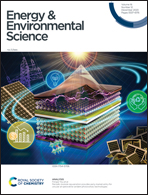Iodine-trapping strategy for light-heat stable inverted perovskite solar cells under ISOS protocols†
Abstract
It's a big challenge for perovskite solar cells (PSCs) to realize operational stability simultaneously under light and heat conditions according to the International Summit on Organic Photovoltaic Stability (ISOS). One key reason lies in that light-induced iodine in perovskite will escape under heat conditions, accelerating perovskite degradation and generating large Pb0 defects. Here, an iodine-trapping strategy is proposed to fabricate operationally stable PSCs through introducing an iodine trapper of β-cyclodextrin (β-CD). β-CD can trap the iodine generated in perovskite and inhibit their escape owing to its bowl structure. Besides, the trapped iodine can react with and eliminate Pb0 in perovskite films, further improving device stability. The resulting PSCs retain 91.8% of the highest efficiency under ISOS-L-1 after MPP tracking for 1000 hours at 25 °C. Importantly, PSCs with β-CD meet the requirements of the ISOS-L-2 protocol, retaining 81.2% (88.5% of initial value) of the highest efficiency after MPP tracking for 300 hours at 85 °C.



 Please wait while we load your content...
Please wait while we load your content...